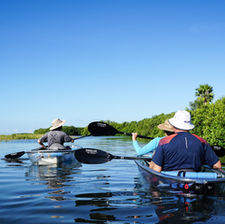
RESTORATION GUIDELINES
Now more than ever before there is a massive public and private interest in recovering mangrove ecosystems at scale. With this excitement for mangrove restoration, it is imperative to ensure successful mangrove restoration interventions.
The Best Practice Guidelines for Mangrove Restoration brings together the latest accumulated local and scientific knowledge about mangrove restoration best-practices into one comprehensive resource. The aim is to align mangrove practitioners, NGOs, governments, scientists, industry, local communities and funders around accepted best-practices for science-based and inclusive mangrove restoration.
A JOINT VENTURE

WHAT WE BRING
-
Step-by-step guidance on best practices for every phase of the mangrove restoration project cycle - project design, funding and implementation.
-
Centered on well-established community-based ecological restoration approaches that enhance restoration success and longevity.
-
The latest best practices with links to useful resources, gathered into one place for the first time.
-
Sub-modules on blue carbon:
-
How to align mangrove restoration with national climate mitigation targets
-
How to produce carbon credits to fund long-term project maintenance, monitoring and community benefits
-
-
Additional modules related to coastal protection, biodiversity and fisheries.
GUIDING PRINCIPLES
-
Safeguard nature and maximize biodiversity
-
Employ the best information and practices
-
Empower people and address their needs
-
Align to the broader context – operate locally and contextually
-
Design for sustainability
-
Mobilize high-integrity capital


URGENT ACTION
Of the 1,100,000 ha of mangroves that have been lost since 1996, around 818,300 ha of mangroves are considered to have high “restorable” potential. Urgent collective action is needed to restore damaged or destroyed mangroves around the world. If done properly, restoration can enhance coastal resilience, fisheries productivity, aquaculture, biodiversity and carbon sequestration.
ACCURACY
BEST PRACTICE
CO-BENEFIT






































